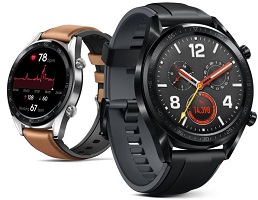Amidst all the hullabaloo around its AI-infused Mate 20 series smartphones, Huawei actually announced another product today. The Chinese technology giant unveiled the Huawei Watch GT, the follow up to the 2015 Huawei Watch and the sportier 2017 Huawei Watch 2.
The company also quietly introduced the Huawei Band Pro 3, the latest in its Band-branded sports wristband line.
As with the Mate 20 phones, many of the details of the Huawei Watch GT actually leaked in the build up to today’s event, so we already had some idea of what to expect. But at a packed event in London today, Huawei officially announced everything.
The Huawei Watch GT is available in two versions — Sport and Classic — which come with a 1.39-inch circular AMOLED screen with 454 x 254 display, plus a 420mAh battery. More importantly, it comes with built-in GPS, an optical heart-rate monitor (HRM), and the usual array of sensors such as an accelerometer.
It’s worth noting here that Huawei has elected to ditch Android Wear OS for the Watch GT, using its own LiteOS instead, which has shown up previously in a Huawei fitness tracker, in addition to IoT devices from third-party manufacturers. But without Android Wear, the Huawei Watch GT will lack many of the third-party app integrations out of the box. But on the flipside, this switch is what has enabled Huawei to improve the battery life.
Indeed, battery life is a major selling point of the Huawei Watch GT, with a promise of up to 30 days of battery when in watch mode (deactivate GPS, for example), while it also promises 14 days of battery life in normal activity tracking mode (no GPS), and 22 hours of continuous exercise tracking with GPS activated.
Meanwhile, the Huawei Band 3 Pro sports a full 0.95-inch color touchscreen, with support for “a range of precise and professional” medical monitoring capabilities, including heart-rate and sleep monitoring.
Huawei also promises big data analysis to serve up personalized advice to improve sleep quality.
At the time of writing, Huawei has only revealed pricing for these two devices in euros. The Huawei Watch GT Sport will cost €199, while the Watch GT Class will set you back €249. The Huawei Band 3 Pro will cost €99.
The “AI Color” video effect on the new Huawei Mate 20 Pro
Huawei Mate P20 Pro: AI Cinema effect adds ‘Sin City’-like color isolation to your videos
Huawei Mate 20 Pro
Huawei unveils Mate 20 and Mate 20 Pro with in-screen fingerprint sensor and built-in wireless charging pad
Apple apologizes for phishing scam account hack in China
LogMeIn
LogMeIn’s Prompt ai and RescueAssist add AI smarts to self-service IT
Hinge’s We Met feature asks users to privately share how a date went.
Hinge now wants to know how your date went so it can make better matches
Amidst all the hullabaloo around its AI-infused Mate 20 series smartphones, Huawei actually announced another product today. The Chinese technology giant unveiled the Huawei Watch GT, the follow up to the 2015 Huawei Watch and the sportier 2017 Huawei Watch 2.
The company also quietly introduced the Huawei Band Pro 3, the latest in its Band-branded sports wristband line.
As with the Mate 20 phones, many of the details of the Huawei Watch GT actually leaked in the build up to today’s event, so we already had some idea of what to expect. But at a packed event in London today, Huawei officially announced everything.
The Huawei Watch GT is available in two versions — Sport and Classic — which come with a 1.39-inch circular AMOLED screen with 454 x 254 display, plus a 420mAh battery. More importantly, it comes with built-in GPS, an optical heart-rate monitor (HRM), and the usual array of sensors such as an accelerometer.
It’s worth noting here that Huawei has elected to ditch Android Wear OS for the Watch GT, using its own LiteOS instead, which has shown up previously in a Huawei fitness tracker, in addition to IoT devices from third-party manufacturers. But without Android Wear, the Huawei Watch GT will lack many of the third-party app integrations out of the box. But on the flipside, this switch is what has enabled Huawei to improve the battery life.
Indeed, battery life is a major selling point of the Huawei Watch GT, with a promise of up to 30 days of battery when in watch mode (deactivate GPS, for example), while it also promises 14 days of battery life in normal activity tracking mode (no GPS), and 22 hours of continuous exercise tracking with GPS activated.
Meanwhile, the Huawei Band 3 Pro sports a full 0.95-inch color touchscreen, with support for “a range of precise and professional” medical monitoring capabilities, including heart-rate and sleep monitoring.
At the time of writing, Huawei has only revealed pricing for these two devices in euros. The Huawei Watch GT Sport will cost €199, while the Watch GT Class will set you back €249. The Huawei Band 3 Pro will cost €99.














